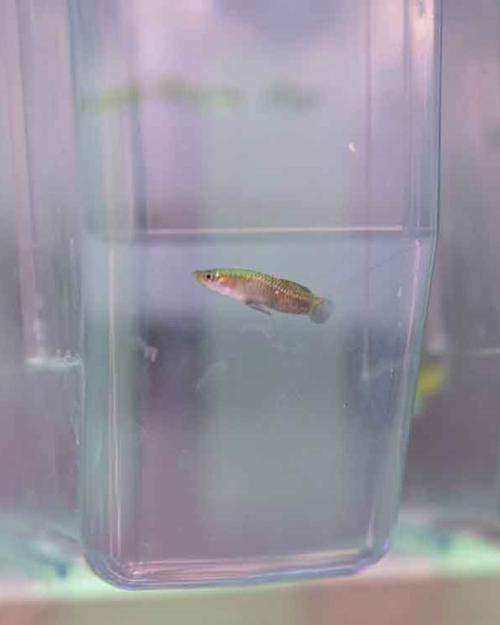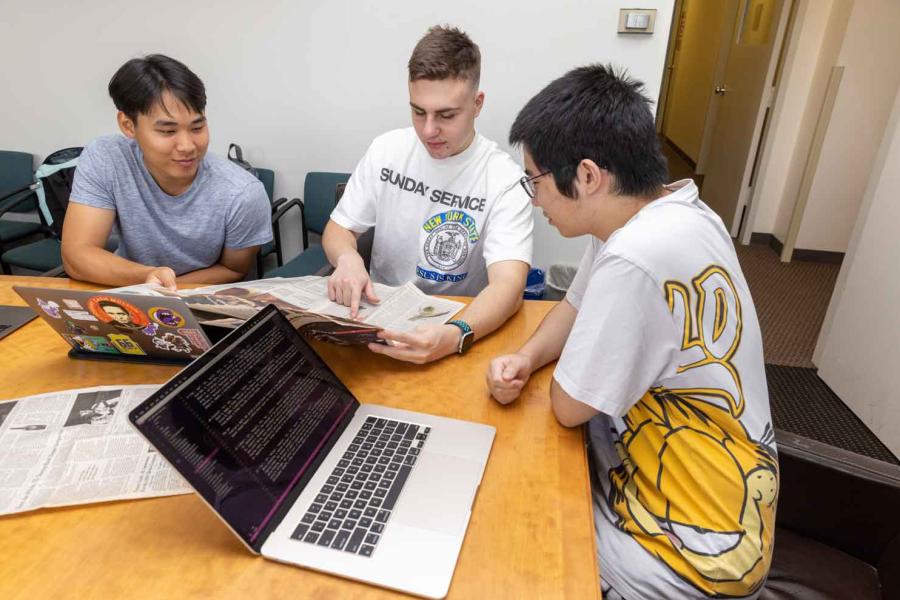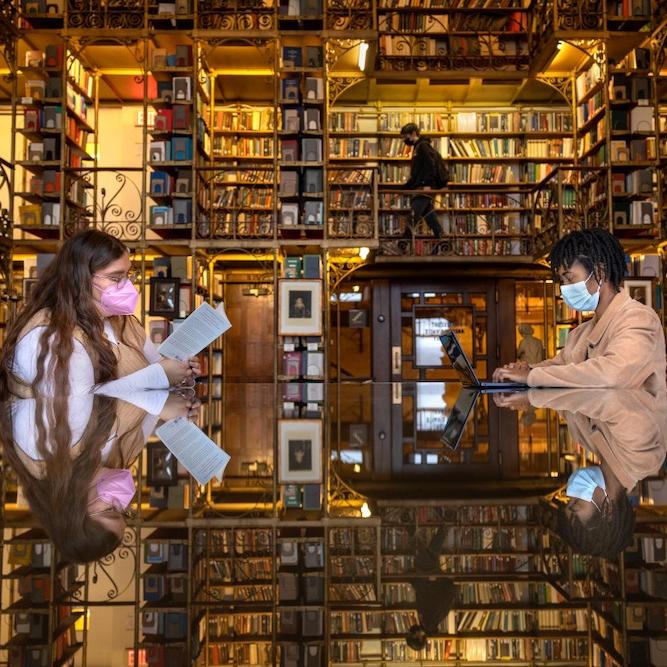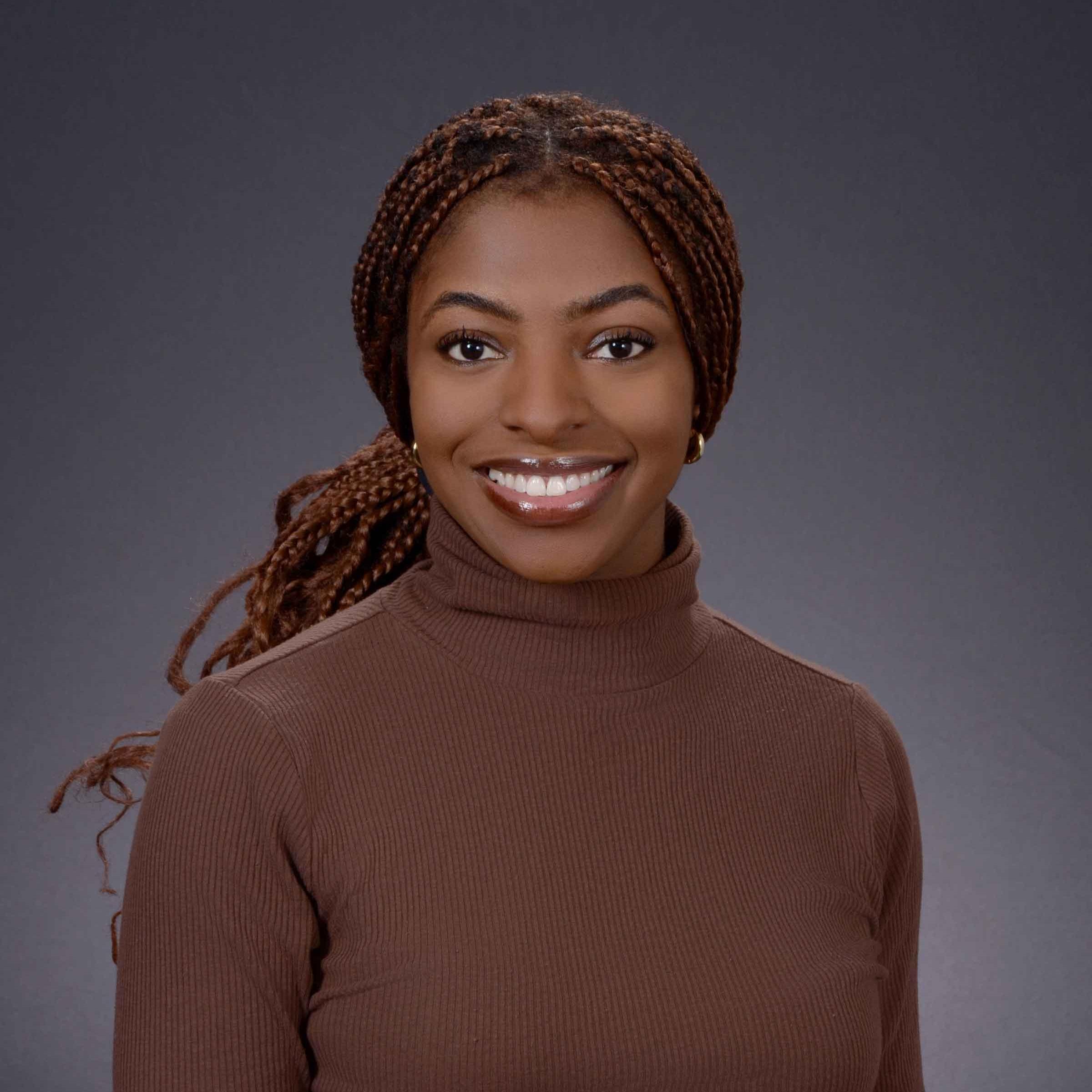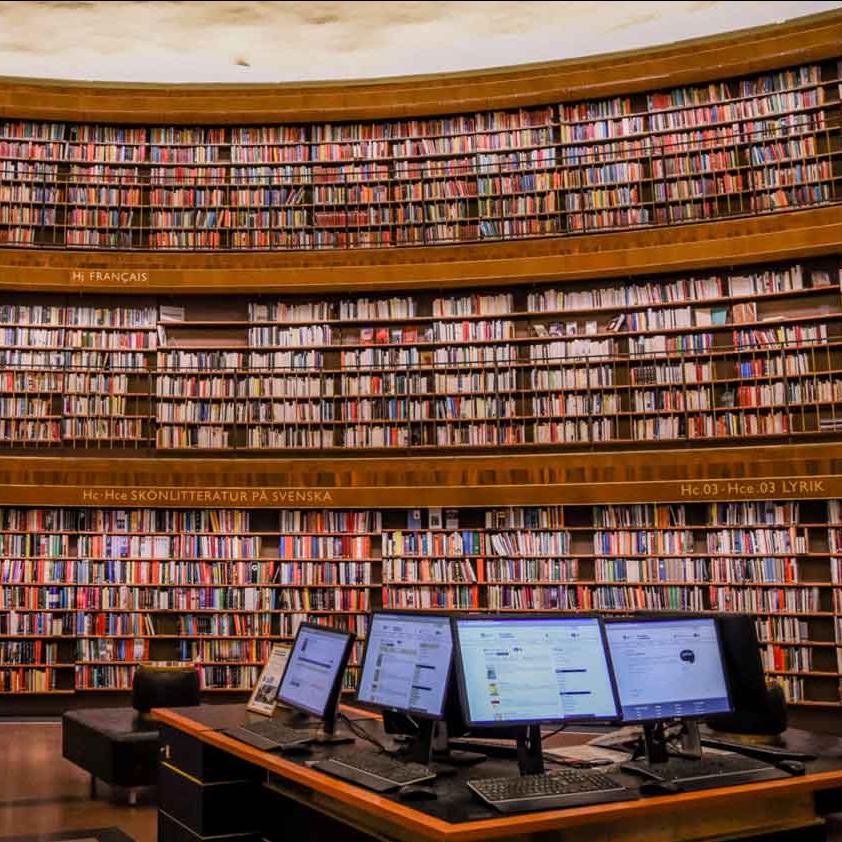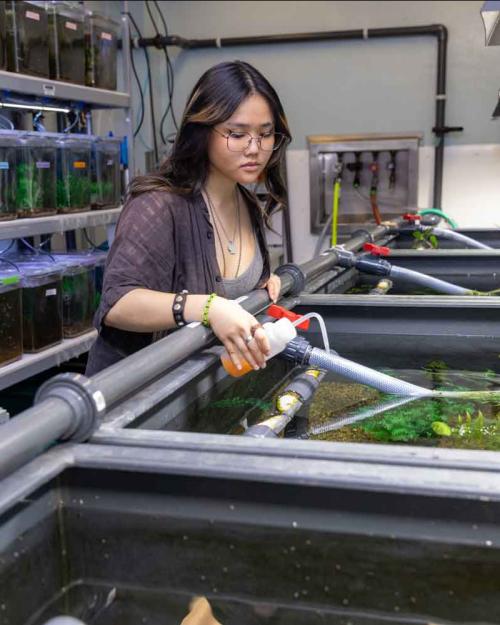This summer, Blythe Wong ’25 has been “fishing for answers” to understand how genes and hormones shape the way organisms look and behave, working with thousands of tiny Poecilia parae fish swimming in the aquariums of Ben Sandkam’s lab in Mudd Hall. Sandkam in an assistant professor in the Department of Neurobiology and Behavior in the College of Arts & Sciences.
Wong has not only been interacting directly with the fish — breeding and feeding them — but has also been working at the molecular level to extract RNA, separate DNA and develop new assays for gene expression.
“As someone who's into marine biology, being able to work with fish is very exciting,” said Wong, who’s majoring in biology with a concentration in microbiology and interests in genetics. “This position is perfect for me because it combines the test organism that I'm the most interested in with the type of research I want to do.”
Wong is one of 101 Nexus Scholars who spent eight weeks this summer working with researchers on campus on projects in the humanities, social sciences and physical sciences. From compiling oral histories of Asian American Cornellians to using artificial intelligence to find patterns in New York Times obituaries to studying genetic diversity in fish, student research this summer was broad and deep.
The Nexus Scholars Program, in its second summer, offers students the chance to work with a Cornell research lab, join in weekly career development and networking sessions and form a cohort of other students interested in research. Scholars presented their research at a July 26 event to celebrate the end of their summer projects, though many plan to continue with their labs during the fall semester.
"The Nexus Scholars program provides meaningful opportunities for undergraduate students, and faculty and their research groups. It is amazing to watch students start the summer a bit unsure about research and end it by confidently explaining and owning their projects, and describing how the skills they learned will be useful for their future careers," said Michelle Smith, senior associate dean for undergraduate education and the Ann S. Bowers Professor of Ecology and Evolutionary Biology. "A&S is enormously proud of the students and so grateful to the research mentors for providing these opportunities."
‘I feel like a scientist now’
During the summer, Wong studied the hormone receptor genes that bind to androgens in the fish and specifically how they are differentially used across tissues within individuals, and across individuals to generate diversity. Her work helps Sandkam’s team further its research into the diversity of strategies that animals use in reproduction and how these strategies influence the evolution of species.
“We often don't have a good sense of how much genetic diversity there is in populations, especially around the X and Y chromosomes,” Sandkam said, “but we're finally at a point with sequencing technologies that we can start to really dive into these regions of the genome.“
Sandkam chose to work with Poecilia parae because the species includes five distinct male morphs with different traits and strategies used during courtship.
As the first researcher to successfully breed these fish in captivity, Sandkam hopes to learn more about the genetic mechanisms that generate diversity within and across species.
His work could also help scientists improve animal population health, learn more about human genetic diversity or study how species are reacting to climate change.
“Some regions of the genome don’t adapt as quickly as others. Understanding how species are going to be able to deal with climate change can actually be informed from understanding how sex chromosomes themselves and important genes on sex chromosomes are either adapting or not able to adapt to rapid changes in the environment,” he said.
An international student from Hong Kong, Wong said the experience cemented her desire to work in research.
“I appreciate the amount of freedom I’ve been given by Professor Sandkam to explore my own project and plan out what steps I need to take to move forward,” she said. “I’ve been learning that the scientific process is built of many small steps that you don’t even see in the final paper. I finally feel like a real scientist.”
And for Sandkam, having a student full-time for the summer has been a “game-changer.”
“Any scientific project takes a tremendous amount of time, in terms of discovering what's going on, finding out what you want to do and tweaking your reactions as you move forward,” he said. “It's hard to do that during the school year when there's only a couple hours a week available in a student’s schedule.”
Spending quality time in the lab helps students develop what Sandkam calls their “bench intuition,” a sense of how to overcome unforeseen challenges during a project so that you still have an informative study. “What really is launching a career in science is the understanding and comprehension of the whole picture of how we're driving questions forward; how we're answering them and how they change the future questions that we ask.”
Creating a database to study how people are remembered
Three Nexus scholars spent their summer helping David Strang, professor of sociology (A&S), move forward with a project using obituaries from the New York Times to learn about how people are memorialized.
Max Bohun ‘25, Thomas Cui ‘25 and Elliott Kim ‘25, all computer science and information science majors, used artificial intelligence, including large language models and natural language processing, to scan obituaries from the last 150 years and develop a database that helps Strang determine the occupations, genders, ethnicity, race, religion, importance and connections of people who earn a Times obituary.
They’re also recording the length of an obituary, surmising that longer obits equate to greater importance, and they’re searching for people who are mentioned in other people’s obituaries — No. 1 is Richard Nixon, next is Ronald Reagan.
“We can use obituaries as a way of seeing how society has evolved over time,” Strang said. “They show what we are interested in, what we value and who we remember.”
Students say the project has required them to learn new skills and programs.
“I’m using the Falcon large language model that’s only weeks old, similar to ChatGPT,” Bohun said. “I had to learn it and then teach the model how to do what we want it to do.”
As of the start of July, the students had processed more than 11,000 obituaries going back to 2017, uncovering 1,000 different occupations. The most popular occupational field for this period is entertainment, but Strang knows that will not be true for older obits, which often focus on businesspeople or politicians, he said.
The students also worked to separate the obituaries into different categories, based on topics such as world wars or periods in history.
Strang plans to continue analyzing the data this fall as he works on publications related to this work. There have been other academic studies of Times obits, but none that take advantage of modern computational tools, he said.
Documenting the impacts of Asian American students on campus
Emily Vo ’25 and Sia Gu ’25 leaned into a different set of skills as they worked on the Cornell Asian American Oral History Project as their Nexus Scholar project.
Begun last year, the project is gathering oral histories of alumni and community members about their experience as a member of Cornell’s Asian-American community and about the development of the Asian American studies program, which was founded in 1987.
Vo and Gu spent the summer transcribing past interviews, conducting more interviews and planning for a public-facing way to share the histories, either on the web, through social media or by outreach events such as pop-up showcases on campus or exhibits in the community.
The project will present a more well-rounded view of Asian American students at Cornell over the years and the work those students did to improve campus conditions and create the Asian American Studies Program.
“People of Asian descent in higher education are often represented as the model minority, with all of the baggage that comes with that,” said Derek Chang, associate professor of history (A&S) and one of the leaders of the project. “A lot of that has to do with not participating in certain activities such as activism. It’s important for people to know that, whether through protest or community building, Cornell’s Asian and Asian American students have a history of being active and trying to make change.”
Vo and Gu said the project helps them to think about their place in the history of Cornell students who are of Asian descent.
“This project has challenged me to think about the future,” Vo said. “When the Supreme Court struck down affirmative action, I kept thinking about this oral history project because APAA (Asian Pacific Americans for Action at Cornell) did a social media campaign supporting affirmative action. I hope as more generations of Asian and Asian American students come to Cornell, they can realize they are a part of a longstanding community.”
The work helped Gu ground the theories she’s learning in class — and the readings she did as she began the oral history project — in real life, “In doing the interviews, I learned how I can engage with the community around me,” she said, “and how I can present my research to the world.”
Associate Professor Christine Bacareza Balance, the other faculty leader of the project, associate professor of performing & media arts and Asian American studies (A&S) and director of the Asian American Studies Program, said the project helps current students realize the importance of collaborative activism.
“There are empowering practices students can do on campus that work against the mainstream culture of competitiveness and professionalization,” she said. “Our student groups today are gathering together and working toward goals that are not about individual success and achievement. We’re discovering that this has been a constant and recurring theme for Cornell students. It’s a story that needs to be amplified and told.”


